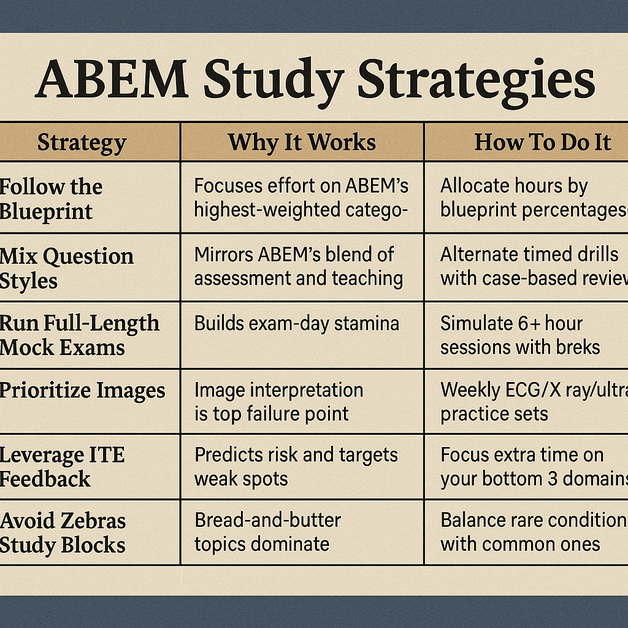The ABEM Board Exam: A Comprehensive Guide
What Do I Need to Know to Prepare for the ABEM Board Exam?
The American Board of Emergency Medicine (ABEM) board exam is a pivotal milestone for emergency medicine physicians. It is instrumental in validating the skills, knowledge, and expertise of professionals in emergency medicine. Here, we will explore the intricacies of the ABEM exam, offering insights, tips, and strategies to optimize your preparation and performance.
What are the ABEM Exam Dates & Fees?
Certifying Exam

Qualifying Exam

Exam Features
The ABEM Qualifying Exam contains approximately 305 single-best-answer, standard multiple-choice questions that follow the ABEM Blueprint. Each question is in paragraph form with an answer set containing one correct answer and three or four incorrect answers.
The exam is divided into two sections each lasting 3 hours and 10 minutes, separated by a one-hour, scheduled break. The entire exam appointment takes approximately 8 hours to complete with 6 hours and 20 minutes of total testing time.
Each section of the examination consists of both pictorial and non-pictorial multiple-choice questions. Pictorial questions refer to stimulus images such as photos of X-rays, ECGs, rhythm strips, pictures, etc. These images will be presented in a separate tab along with the relevant test question on the computer screen. You will need to interpret ultrasound images for pictorial questions on the Qualifying Exam. Two reference documents are available to you during the exam: a list of common abbreviations used in the exam, and a list of normal laboratory values.
Where Can I Find the Content Specifications for the ABEM Exam?
ABEM follows the EM blueprint for the Qualifying Exam. While questions can originate from any content area within the model, some areas are routinely selected. The lists below describe the relative weight given to different elements of the EM Model in constructing the examinations:
Medical Knowledge, Patient Care, and Procedural Skills
1.0 Signs, Symptoms and Presentations: 10%
2.0 Abdominal & Gastrointestinal Disorders: 7%
3.0 Cardiovascular Disorders: 10%
4.0 Cutaneous Disorders: 3%
5.0 Endocrine, Metabolic & Nutritional Disorders: 5%
6.0 Environmental Disorders: 2%
7.0 Head, Ear, Eye, Nose & Throat Disorders: 4%
8.0 Hematologic Disorders: 3%
9.0 Immune System Disorders: 2%
10.0 Systemic Infectious Disorders: 7%
11.0 Musculoskeletal Disorders (Non-traumatic): 3%
12.0 Nervous System Disorders: 6%
13.0 Obstetrics and Gynecology: 3%
14.0 Psychobehavioral Disorders: 2%
15.0 Renal and Urogenital Disorders: 3%
16.0 Thoracic-Respiratory Disorders: 7%
17.0 Toxicologic Disorders: 4%
18.0 Traumatic Disorders: 9%
19.0 Procedures & Skills: 8%
20.0 Other Components: 2%

Acuity Frames: Target (± 5%)
Critical: 30%
Emergent: 40%
Lower Acuity: 21%
None: 9%
Physician Tasks
For this dimension, the Board has assigned the following specific percentage weights to the Modifying Factor of age:
Pediatrics: 8% minimum
Geriatrics: 6% minimum
Strategizing Your Preparation
Comprehensive Study Material
Choose study resources that are aligned with the ABEM Blueprint, ensuring that you cover every topic in depth. Resources like Med-Challenger Emergency Medicine offer tailored preparation with a vast question bank of constantly updated content.
Procedures and Skills Commonly Tested

Mock Exams and Simulations
Simulated exams, such as Med-Challenger's Board Exam Simulator, part of the Emergency Medicine Boards Prep Course, are instrumental in gauging your preparation level. They offer insights into your strong areas and those requiring improvement, enabling a focused preparation strategy.
👉 What is the Best Emergency Medicine Question Bank?
Time Management
The ABEM exam evaluates candidates under timed conditions. Practice with timed mock exams to enhance your time management skills, ensuring that you can navigate through the questions effectively and efficiently during the actual exam.
👉 How I Prepared for and Passed the ABEM Qualifying Exam
Navigating the Exam Day
Stay Calm
It’s natural to feel anxious. However, staying calm and composed is crucial to think clearly and make informed decisions during the exam. Knowing what to expect by checking out Take & Pass the Exam can also help put your mind at ease.
Pace Yourself
The exam is structured to evaluate a broad spectrum of your skills and knowledge. Pacing yourself is crucial to ensure that every section of the exam is attempted with equal focus and concentration.
Review Your Work
If time permits, review your answers. Sometimes, a second look can offer new perspectives and insights.

👉 ABEM Board Exam: Top Concerns and Solutions
Post Exam
Notification of Examination Results
ABEM sends physicians the results of their examination in writing within 90 days of the date of the exam. Results are also posted on the physician's ABEM Portal. ABEM cannot release your scores over the phone or email. Maintaining up-to-date contact information through your ABEM Initial Certification Page will ensure you receive the results as soon as possible.
Passing Criterion and Scoring
The Qualifying Exam is criterion referenced. A criterion-referenced exam uses a predetermined passing score, which is adopted by the Board as reflecting its performance standards (EM Model and KSAs). All candidates meeting the standard will pass the exam.
Best practice in testing suggests that a passing score for an examination should be reviewed about every five to seven years.
For security purposes the Qualifying Examination is administered using multiple versions. Any given candidate is unlikely to receive the same version of the examination as another candidate. To ensure a fair examination result for all candidates a statistical process called equating is applied following the examination. This ensure that the Board’s passing score remains the same for all candidates. The score resulting from equating is not a percent correct, rather, it is a scaled score that ranges from 0 to 100 and does not include field test items. In addition to the field-testing process, each question receives a thorough review before it is used in scoring the examination. Questions that do not meet ABEM quality standards are not used in determining candidates’ final scores. The entire scoring process is fully and independently replicated. The passing score for the Qualifying Exam was last examined in 2019 and was determined to be a score of 77 out of 100.
ABEM Exam Prep FAQs
Q1: What is the format of the ABEM Qualifying Exam?
A: The ABEM Qualifying Exam has ~305 multiple-choice questions divided into two sections, each lasting 3 hours and 10 minutes, with a one-hour scheduled break. It includes both pictorial questions (e.g., X-rays, ECGs, ultrasounds) and non-pictorial questions, all aligned with the ABEM Blueprint.
Q2: What topics are most heavily weighted on the ABEM exam?
A: According to the ABEM Blueprint, high-yield categories include Signs and Symptoms (10%), Cardiovascular Disorders (10%), Trauma (9%), and Procedures & Skills (8%). Together with GI and Infectious Diseases, these areas make up a large portion of the exam.
Q3: How much time do I need to prepare for the ABEM board exam?
A: Most emergency medicine residents begin structured study 3–6 months before the exam. Using QBank practice, timed mock exams, and blueprint-aligned resources like Med-Challenger helps ensure effective preparation.
Q4: How is the ABEM board exam scored?
A: The Qualifying Exam is criterion-referenced, meaning all candidates who meet the passing standard will pass. Scores are scaled from 0 to 100, with the most recent passing score set at 77. Results are typically released within 90 days via the ABEM portal.
Q5: How can I manage exam-day anxiety for the ABEM boards?
A: Simulate exam conditions ahead of time, pace yourself during the test, and practice relaxation strategies. Staying familiar with the exam format can reduce stress and improve confidence on test day.
Q6: When are the ABEM exam dates and how much does it cost?
A: ABEM publishes its exam schedule for both the Qualifying and Oral Exams each year. Fees vary by exam type and are posted on ABEM’s official website. Candidates should budget for registration and potential travel.
Q7: What resources best prepare me for the ABEM exam?
A: The most effective resources are those mapped to the ABEM Blueprint, offering pictorial practice, strong answer explanations, and exam simulations. Many U.S. residents and attendings choose Med-Challenger for its updated QBank, CME credits, and pass guarantees.
👉 ABEM Study Strategies That Work
How can you prepare for the ABEM Exams? Med-Challenger Emergency Medicine Board Prep







.png)
